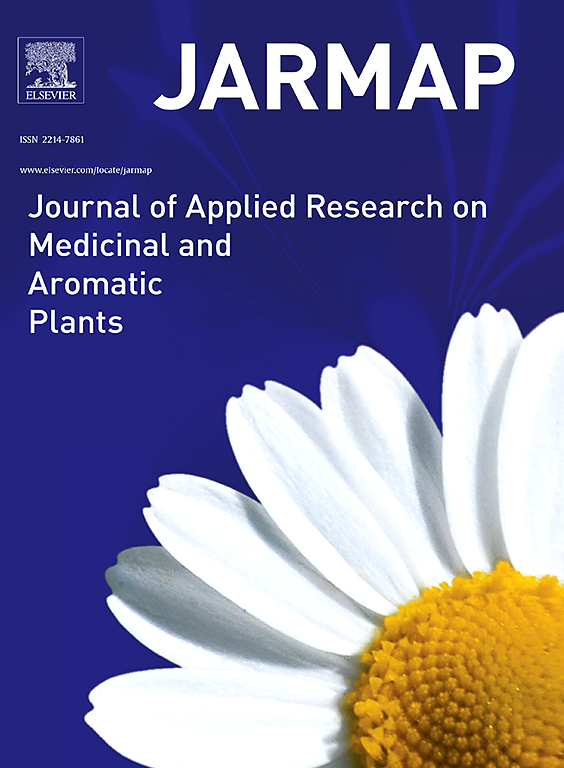为成功种植黑籽(Nigella sativa L.)、车前子(Plantago ovata Forsk)和藜麦(Chenopodium quinoa Willd.)
IF 3.6
2区 农林科学
Q1 PLANT SCIENCES
Journal of Applied Research on Medicinal and Aromatic Plants
Pub Date : 2024-09-13
DOI:10.1016/j.jarmap.2024.100576
引用次数: 0
摘要
黑籽、车前子和藜麦的杂草控制对于成功种植和适应这些药用和营养作物至关重要。近期的研究旨在评估萌芽前除草剂(S-甲草胺和戊唑醇)在这些作物上的应用可能性。这项研究包括对每种作物进行三次实验,为期两年(2020-21 年和 2021-22 年)。在每项实验中,除草剂及其递增剂量(推荐标签剂量的 0%、25%、50%、75% 和 100%)均采用因子排列的随机完全区组设计。收集了有关杂草动态、作物农艺和产量属性的数据。结果表明,两种除草剂的除草效率在 60%-80% 之间。另一方面,作物对两种除草剂的耐受性各不相同。事实证明,嘧草环胺对所有作物的危害都较大。剂量-反应曲线显示,作物对戊唑醇的耐受性可分为黑籽>车前子和藜麦。相反,所有作物都对甲草胺的递增剂量表现出耐受性。根据各自的 Ed50 值,对 S-甲草胺耐受的作物可分为黑籽>藜>车前草。研究得出结论,应避免在这些作物中使用戊唑醇。不过,S-甲草胺可作为一种萌芽前除草剂,以推荐的标签剂量用于黑籽、车前草和藜麦的种植。本文章由计算机程序翻译,如有差异,请以英文原文为准。
Pre-emergence herbicide selection for successful cultivation of black seed (Nigella sativa L.), psyllium (Plantago ovata Forsk), and quinoa (Chenopodium quinoa Willd.)
Weed control in black seed, psyllium, and quinoa is of huge importance for successfully cultivating and adapting these medicinal and nutritious crops. The recent study was designed to evaluate the pre-emergence herbicides (S-metolachlor and pendimethalin) for their possible application in these crops. The study consisted of three experiments on each crop for two years (2020–21, 2021–22). In each experiment, herbicides and their incremental doses (0 %, 25 %, 50 %, 75 %, and 100 % of recommended label dose) were applied under a randomized complete block design under the factorial arrangement. Data on weed dynamics, crop agronomic, and yield attributes were collected. Results revealed that the weed control efficiency of both herbicides ranged from ∼60–80 %. Crops, on the other hand, varied in their tolerance to both herbicides. Pendimethalin proved to be more detrimental for all the crops. Dose-response curves showed the crop tolerance to pendimethalin and can be ranked as black seed>psyllium and quinoa. Contrastingly, all the crops showed tolerance to the incremental dose of S-metolachlor. Crops tolerance to S-metolachlor can be ranked as black seed>quinoa>psyllium as per their respective Ed50 values. The study concluded that pendimethalin use in these crops should be avoided. However, S-metolachlor can be employed as a pre-emergence herbicide in the cultivation of black seed, psyllium, and quinoa at the recommended label dose.
求助全文
通过发布文献求助,成功后即可免费获取论文全文。
去求助
来源期刊

Journal of Applied Research on Medicinal and Aromatic Plants
Pharmacology, Toxicology and Pharmaceutics-Drug Discovery
CiteScore
6.40
自引率
7.70%
发文量
80
审稿时长
41 days
期刊介绍:
JARMAP is a peer reviewed and multidisciplinary communication platform, covering all aspects of the raw material supply chain of medicinal and aromatic plants. JARMAP aims to improve production of tailor made commodities by addressing the various requirements of manufacturers of herbal medicines, herbal teas, seasoning herbs, food and feed supplements and cosmetics. JARMAP covers research on genetic resources, breeding, wild-collection, domestication, propagation, cultivation, phytopathology and plant protection, mechanization, conservation, processing, quality assurance, analytics and economics. JARMAP publishes reviews, original research articles and short communications related to research.
 求助内容:
求助内容: 应助结果提醒方式:
应助结果提醒方式:


